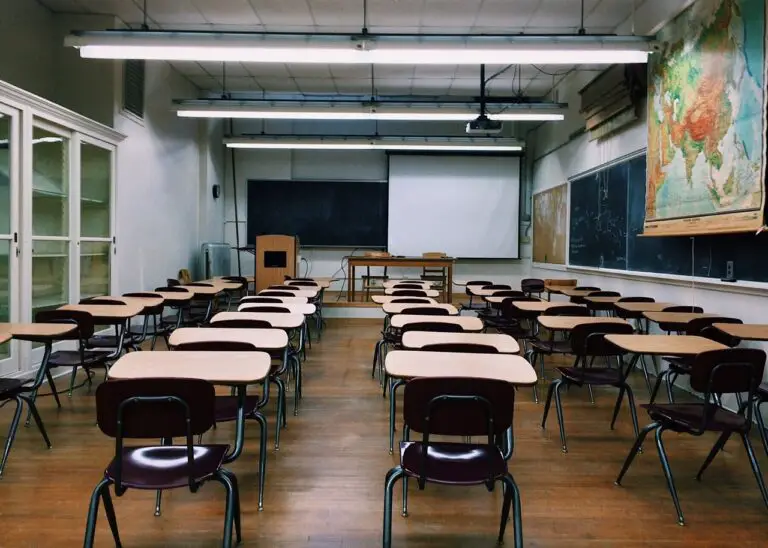Can Public Schools Refuse to Enroll a Student? Understanding the Legal Basis for Enrollment Denial
Public schools are an essential part of the education system, and they must provide education to all students who reside within their district’s boundaries.
However, there are situations where a public school may refuse to enroll a student.
Generally, public schools cannot refuse to enroll a student who resides within their district’s boundaries. However, this rule has a few exceptions, such as expulsion from another school or overcrowding.
Public schools must accept all resident students but may only allow enrollment to students who meet specific requirements.
For example, some states require students to have certain vaccinations before enrolling in public schools. In such cases, schools may deny enrollment to students who do not meet the vaccination requirements.
Parents and students have certain rights when it comes to public school enrollment. Every child is entitled to a free public school education in the United States.
However, there may be additional expenses that parents still have to pay. Parents can investigate state, district, and school policies to determine these expenses.
Public schools are also responsible for creating a safe learning environment and cannot ignore harassment or threats based on a student’s appearance or behavior.
Public School Enrollment: A Constitutional Right
Access to education is a fundamental right in the United States, including free public school education. The Constitution affirms this right, and various federal and state laws support it.
In 1982, the United States Supreme Court decided in the case of Plyler v. Doe, affirming that children without legal immigration status have an equal right to receive a free public education, just like any other child.
This ruling established that access to education is a right for all children, regardless of their background or circumstances.
🌟 Hey Students! 🚀 Ready for the ultimate experience? Join us on Studentsinside.com's Facebook, YouTube, WhatsApp, and LinkedIn. Click now for tips, fun, and success vibes! 🌈✨ #StudentLife #JoinUs
Furthermore, the rights of all children to enroll in school are protected by federal laws such as the Individuals with Disabilities Education Act (IDEA) and the Americans with Disabilities Act (ADA).
These regulations guarantee that kids with disabilities can access education equally without discrimination.
It is important to note that while public schools must enroll all children, there are some exceptions. For example, if a student poses a threat to the safety of others, the school may deny enrollment.
Additionally, schools may require proof of residency within the school district, but they cannot deny enrollment based on a student’s race, gender, religion, sexual orientation, or other protected characteristics.
Federal and State Laws Governing School Enrollment
Enrollment in public schools is governed by federal and state laws that ensure equal access to education for all students.
These laws make it illegal to treat people unfairly because of their race, skin color, where they come from, gender, or disabilities. Moreover, each state has its own set of rules and regulations that control who can attend school.
The 1964 Civil Rights Act oversees school enrollment. Title VI in this law stops discrimination in programs and activities getting federal funds due to race, color, or national origin.
Title IX in the same Act prevents discrimination based on gender in education programs and activities receiving federal financial aid.
The Department of Education enforces these laws and ensures that schools comply. The Department of Education has guided schools on how to comply with these laws and provided technical assistance to schools that need help complying with them.
States also have their laws and regulations that govern school enrollment. These laws vary from state to state but generally require that all children between the ages of 5 and 16 attend school.
States also set maximum age limits, and attendance is no longer permitted if students have yet to graduate by the time they reach this age.
School districts may establish bona fide residency requirements and require students to show proof of residency to enroll in a district school. However, these requirements must not have a chilling or discouraging effect on student enrollment.
Schools must also ensure that their enrollment policies do not discriminate against students based on race, color, national origin, sex, or disability.
Prohibited Grounds for Refusal of Enrollment
Public schools must provide enrollment to all students who meet their state’s age and residency requirements. However, schools must abide by specific prohibited grounds for refusal of registration.
These reasons stem from federal and state laws forbidding schools from discriminating against students due to their race, color, national origin, gender, religion, immigration status, citizenship status, age criteria, or disabilities.
Thanks to the Civil Rights Act of 1964, schools that receive federal funding are not allowed to show any discrimination against students based on their race, color, or national origin. Without federal funding, schools cannot reject students based on race, color, or national origin.
Schools also cannot have policies or practices that have a discriminatory effect on students based on these factors.
Similarly, Title IX from the 1972 Education Amendments bars any form of gender-based discrimination in educational programs or activities funded by the federal government.
This implies that schools are not allowed to deny a student enrollment due to their gender, nor can they implement policies or actions that unfairly affect students based on gender.
Schools also cannot discriminate against students based on their religion. The First Amendment in the U.S. Constitution guarantees the right to freedom of religion, and schools must respect this right.
Schools cannot refuse enrollment to a student based on their religion or have policies or practices that have a discriminatory effect on students based on their religion.
Furthermore, schools cannot discriminate against students based on their immigration or citizenship status.
The Supreme Court has ruled that undocumented students have a right to attend public schools, and schools cannot require proof of citizenship or immigration status as a condition of enrollment.
Schools also cannot have policies or practices that have a discriminatory effect on students based on their immigration or citizenship status. In addition, schools cannot discriminate against students based on age or disability.
The Individuals with Disabilities Education Act (IDEA) requires schools to provide a free appropriate public education (FAPE) to students with disabilities, and schools cannot refuse enrollment to a student based on their disability.
Schools also cannot have policies or practices that have a discriminatory effect on students based on their age or disability.
Discrimination in Public Schools
Several federal and state laws prohibit discrimination in public schools. These laws outlaw discrimination based on race, ethnicity, religion, sex, disability, and other factors.
Discrimination can manifest in various ways, like harassment, bullying, exclusion, and the unfair denial of educational opportunities.
The American Civil Liberties Union (ACLU) is one organization that works to protect the rights of students against discrimination in public schools.
The ACLU provides information and resources to help students and parents understand their rights and take action when those rights are violated.
The Office for Civil Rights (OCR) is another entity that investigates complaints of discrimination in public schools.
The OCR is part of the U.S. Department of Education and is responsible for enforcing federal civil rights laws prohibiting discrimination in educational programs and activities.
The Department of Justice’s Civil Rights Division is dedicated to safeguarding students’ rights in public schools by investigating and taking legal action against cases of discrimination rooted in factors like race, color, national origin, gender, disability, and religion.
It is crucial for students and parents to be aware of their rights and to take action when those rights are violated. Suppose a student or parent believes discrimination has occurred.
In that case, they should contact the appropriate entity, such as the ACLU, OCR, or Civil Rights Division, to file a complaint and seek assistance.
Enrollment Policies and Procedures
Enrolling a student in a public school involves following specific policies and procedures. Each school district may have its policies and procedures but must comply with state and federal laws.
The Pennsylvania Department of Education guides public school enrollment procedures for resident and non-resident children.
For a student to be registered, the school district or charter school must collect evidence of the child’s age, immunization confirmation, and residency verification.
Only information can be required as a condition of enrollment for administrative purposes or to assist with the child’s educational needs.
School districts cannot refuse enrollment to a student who resides within the school district’s boundaries except in certain circumstances.
For example, a student may get kicked out of a different school or have to leave if their new school is too full. Each state sets rules about how old you must be to start school. Usually, kids between 5 and 16 have to go to school.
Enrollment disputes may arise when a school unlawfully refuses to enroll a student. The enrollment complaint process applies to all public schools, including charter and cyber charter schools.
Enrollment disputes may occur when a student is homeless, has a disability, or is an English language learner. In such cases, the school district must provide additional assistance to ensure the student’s enrollment.
Special Considerations for Enrollment
Enrollment in public schools is generally available to all students who reside within the school district’s boundaries. However, schools must consider some special considerations when enrolling students.
For students with disabilities or special needs, public schools are required by federal law to provide a free and appropriate education. Schools must make themselves accessible to all students regardless of physical condition.
This means schools need ramps, elevators, and special tools to help students with disabilities access the same learning opportunities as others.
Pregnant students are also entitled to enroll in public schools. Schools cannot discriminate against pregnant students and must provide them with the same educational opportunities as non-pregnant students.
Additionally, pregnant students are entitled to take medically necessary absences related to their pregnancy and childbirth.
For homeless children, public schools must provide immediate enrollment, regardless of whether the child has the necessary paperwork or has missed enrollment deadlines.
Schools must also provide transportation to and from school and ensure that homeless children can access all school programs and services.
Finally, for students who are English language learners, public schools must provide English language instruction to help them acquire proficiency in English.
Schools must also ensure that English language learners have access to all school programs and services and are not discriminated against based on their language proficiency.
Documentation Requirements for Enrollment
When enrolling a student in a public school, specific documentation is required to prove the student’s eligibility to attend. The following are typical documentation requirements for enrollment:
Proof of Age
To enroll in a public school, a student must meet the state’s age requirements for attendance. Typically, children between the ages of 5 and 16 must attend school, but these requirements vary by state.
To prove a student’s age, acceptable documentation includes:
- A birth certificate.
- A notarized copy of a birth certificate.
- A baptismal certificate.
- A statement from the parents or another relative indicating the date of birth.
Proof of Residency
Public schools are typically only available to students within the district’s boundaries. To prove residency, families may be required to provide documentation such as a utility bill, lease agreement, or property tax bill. It is important to note that each school district may have its specific requirements for proof of residency.
Social Security Number
While only sometimes required, some schools may ask for a student’s social security number as part of the enrollment process. This information is typically used to record and verify a student’s identity.
Disciplinary Records
In certain circumstances, schools may request disciplinary records from a student’s previous school as part of the enrollment process.
This is typically done to ensure the safety of other students and staff members. However, schools must follow specific procedures when requesting and reviewing disciplinary records to protect students’ privacy rights.
Remember, the documents you need for enrollment can differ depending on your state and school district. Contact your local school district to find out exactly what’s required.
Appealing Enrollment Decisions
When a public school refuses to admit a student, the student or their parent/guardian can challenge the decision.
The specific steps for this appeal may differ from one state or district to another. Still, it usually includes sending a written appeal to the school board or the superintendent.
In the appeal, the student or their parent/guardian should clearly state why they believe the enrollment decision was wrong or unfair.
They should provide any supporting documentation or evidence that may help their case, such as proof of residency or medical records.
Make sure to remember that the appeals process has strict deadlines and rules. Be sure to follow all the instructions carefully to avoid having your appeal denied or dismissed.
If the appeal is denied, the student or their parent/guardian may file a complaint with the State Department of Education or the U.S. Department of Education’s Office for Civil Rights. The complaint should detail the alleged discrimination or violation of rights that led to the enrollment denial.
It is important to remember that while appealing an enrollment decision may be an option, public schools generally must accept all resident students within their district’s boundaries. Exceptions to this may include expulsion from another school or overcrowding, but these are rare cases.
Alternatives to Public School Enrollment
While public schools must accept all resident students, there are alternative options for families who choose not to enroll their children in public schools. Here are a few alternatives to consider:
Private School
Private schools are an option for families who want to provide their children with a different educational experience than public schools. Private schools are not required to accept all students and can have their admission requirements.
They can also have different curriculums, teaching styles, and extracurricular activities. Private schools can be expensive, but some offer financial aid or scholarships.
Homeschooling
Homeschooling offers families an alternative for greater involvement in their children’s education. It permits parents to customize their kids’ learning according to their requirements and passions.
Homeschooled children can engage in extracurricular activities and interact with peers by joining homeschooling clubs and local community groups.
While homeschooling demands substantial time and commitment from parents, it can also be a fulfilling and enriching journey.
Open Enrollment
Open enrollment allows families to enroll their children in schools outside of their designated school district. This can be a good option for families who want their children to attend a school with a specific program or curriculum.
Open enrollment policies vary by state and school district, so it’s essential to research the policies in your area. Some schools may have limited available enrollment spots, so applying early is critical.
Promoting Diversity and Tolerance in Schools
Public schools have a responsibility to promote diversity and tolerance among their students.
Schools can foster community and respect for individual differences by providing all students with a safe and inclusive environment.
Schools can promote diversity by offering educational opportunities that reflect their student population’s cultural, linguistic, and socioeconomic diversity.
This can include providing access to language classes, cultural celebrations, and other programs that celebrate diversity and promote understanding.
Another critical aspect of promoting diversity and tolerance in schools is addressing issues of discrimination and bias. Schools can work to create policies and procedures that ensure all students are treated fairly and equitably, regardless of their race, gender, religion, or sexual orientation.
Schools can also encourage students to develop empathy and understanding for others by incorporating opportunities for community service and volunteer work into their curriculum.
This can help students learn about the challenges others face and develop a greater appreciation for the diversity of experiences and perspectives in their community.
Controversial Issues in School Enrollment
Enrolling in a public school is a fundamental right for every child. However, some controversial issues surrounding school enrollment have been the subject of debate and legal action. These issues include transgender students, bathroom policies, corporal punishment, dress codes, and bullying.
Transgender students have been at the center of many enrollment controversies. Some schools have refused to enroll transgender students, while others have implemented policies that discriminate against them.
The Department of Education has issued guidelines to schools on protecting transgender students from discrimination.
The rules let transgender students use the bathrooms and changing rooms that match their gender identity. Bathroom policies are causing debates in schools.
Some schools have enforced rules mandating students to use bathrooms based on their biological sex, while others have adopted policies permitting students to choose bathrooms that match their gender identity.
The latter policy has been the subject of legal action, with some states and school districts implementing laws requiring students to use bathrooms corresponding to their biological sex.
Corporal punishment is another controversial issue in school enrollment. Some schools still allow corporal punishment, while others have banned it. Corporal punishment has been linked to negative outcomes, such as increased aggression and decreased academic performance.
Dress codes have also been a source of controversy in school enrollment. Some schools have implemented dress codes that are seen as discriminatory, such as codes that prohibit students from wearing certain hairstyles or clothing associated with a particular race or ethnicity.
Finally, bullying poses a significant problem in the context of school enrollment. Schools must ensure a secure educational atmosphere for every student, and bullying can lead to serious repercussions for those targeted.
Schools have implemented policies to prevent bullying, such as anti-bullying programs and strict disciplinary action for offenders.







